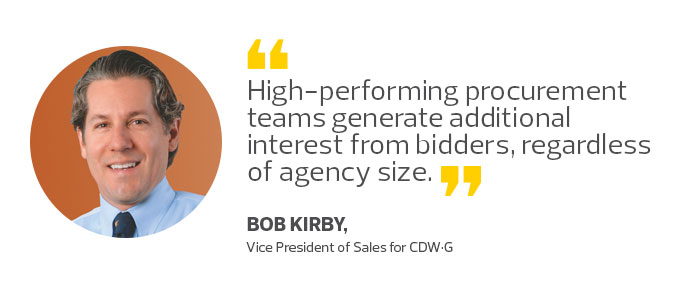Collaborative RFP Strategies Drive Better Public Sector IT
Procurement often serves as the critical link between great ideas for IT innovation and successful projects. A request for proposals presents a complex undertaking, yet comes down to a simple question: Can the RFP take our organization from concept to realization?
An RFP provides the opportunity to hone detail and direction, and focus attention on the practical aspects of a deployment. It also presents potential problems in navigating a rapidly changing technology landscape.
Chief procurement officers and CIOs “face many challenges as states struggle to reform sometimes decades old procurement systems,” NASCIO and the National Association of State Procurement Officials reported in a joint statement earlier this year.
“Leading IT procurement transformation continues to be a priority for state procurement leaders nationally, and NASPO is committed to working with our IT partners to be at the forefront of this effort,” said Lawrence Larry Maxwell, NASPO president and New Mexico State Purchasing Director.
Procurement teams often find themselves understaffed, as a result of retirements, losses to the private sector and agencies not replacing employees let go during the Great Recession. Almost 40 percent of procurement professionals said their teams were stretched or working extra hours to keep up with deadlines, according to a 2017 survey by Onvia, a government business intelligence company. Overworked staff can have a negative impact, including poorly worded bid language, Onvia reports. On the other hand, high-performing procurement teams generate additional interest from bidders, regardless of agency size.
A Meeting of the Minds Sifts Out State RFP Best Processes
To help address those and other challenges, IT officials can take a fresh look at their RFP process and how they work with buyers. In that spirit, NASCIO and NASPO last year convened a joint roundtable to discuss advancing IT and procurement modernization. Leaders had the opportunity to collaborate with peers in other states to discuss obstacles, solutions and next steps.
The roundtable’s participants cited “executive leadership,” “data and analytics,” “new collaborations and partnerships” and “increasing transparency and accessibility” as the most important enablers for IT and procurement modernization. They determined the most significant barriers to be “workforce constraints,” “organizational culture,” “managing issues around control and accountability” and “establishing a governance structure and operating model.”
The event resulted in a joint action plan to redesign how CIOs and chief procurement officers work together. The plan features a recurring theme of three C’s: collaboration, cooperation and communication.

“Ensure early engagement with all agencies involved, including purchasing, IT, legal and other key stakeholders,” the plan states. “Implement strategies to develop mutual respect and understanding between procurement and IT offices.”
The plan speaks to state agencies, but all levels of government will benefit from the insights and prescriptions for best practices.
In IT to Win IT: RFP Standout States
Several states stand out as leaders in bringing innovation to procurement, according to a survey and assessment released in 2016 by the Governing Institute: Georgia, Virginia, Minnesota and Utah ranked in the top four slots, with Massachusetts and Ohio tied for fifth. Those states all began more than a decade ago to modernize their technology and use it to introduce new ideas, according to a report from Governing.
Another commonality: Procurement improvement has the full support of top officials, including governors, “who viewed the procurement office as a place to advance the state’s goals rather than an enforcer that simply ensures the state is buying by the rules,” the report continues.
Ohio provides an example of how IT can support procurement improvement. When the state launched a large modernization and cloud migration program, officials restructured the relationship between IT and procurement by streamlining and clarifying reporting structures. State CIO Stu Davis took ownership of IT procurement and created a shared IT procurement agenda. Procurement now plays more of a consultative role, and agencies need final approval on IT purchases from Davis’ office. The state also set up a CIO Council, a group of industry CIOs that vets state IT ideas and shares trade information.
State and local IT and procurement professionals nationwide can look to Ohio and other examples of procurement reform as guides for improved purchasing and, ultimately, a new level of public sector IT.









